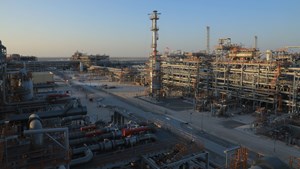BP sells Oman gas stake in push to divest $25B of fossil fuel assets
LONDON (Bloomberg) --BP will sell a stake in an Omani gas block to Thailand’s national energy firm for $2.6 billion, part of a push to divest billions of dollars of assets and focus more on renewable energy.
PTT Exploration and Production Public Co. Ltd. has agreed to pay the sum for 20% of Block 61, according to statements from both companies on Monday.
The deal should help BP deliver on its goal of selling $25 billion of assets by 2025, easing its debt burden after the coronavirus pandemic hammered demand for energy. Like other oil majors, the company has also pledged to eliminate most of its greenhouse gas emissions over the coming decades.
BP’s shares fell to the lowest in around 25 years in October, shortly after it cut its dividend for the first time in a decade and Chief Executive Officer Bernard Looney announced a shift toward greener energy. The London-based firm is due to report fourth quarter earnings on Tuesday, when investors will be paying attention to how much progress BP has made in reducing its liabilities.
The stock rose 0.1% to 271.65 pence by 11:18 a.m. in London, extending gains this year to 6.6%.
The price of the Oman stake is “attractive” for BP compared with historical transactions, analysts at Bernstein including Oswald Clint wrote in a research note. The sale reinforces their view that BP will restart share buybacks as early as mid-2021. The company committed to purchasing its own stock once net debt is trimmed to $35 billion, from around $40 billion at the end of September.
Deal Closing
Block 61 is BP’s biggest asset in Oman and has a combined daily production capacity of 1.5 billion cubic feet of gas and more than 65,000 barrels of condensate, a light form of oil, according to the company.
BP began talks with potential buyers in 2020. It expects the deal to close this year, after which it will remain the block’s operator and its biggest shareholder with 40% ownership.
Of the remainder, Omani state-run firm OQ will hold 30%; PTTEP, 20%; and Malaysia’s Petroliam Nasional Bhd., or Petronas, 10%. Petronas bought its stake from OQ in 2018.
PTTEP already has investments in the sultanate, including a stake in Block 6, which is the country’s largest deposit, and state-controlled Oman Liquefied Natural Gas LLC. It’s expanding in the Middle East. In December, it secured a license to explore for oil and gas off the coast of Abu Dhabi in the neighboring United Arab Emirates.
Fracking Concession
Block 61 has been developed in two phases: Khazzan, which began production in 2017, and Ghazeer, which started operating in October. The block can meet around 35% of Oman’s gas demand, BP said.
The concession area contains the largest tight-gas development in the Middle East, the company said. Khazzan and Ghazeer rely on hydraulic fracturing to boost output, the method that kicked off the U.S. shale boom but is rarely used elsewhere.
Gas produced at the block, which spans 3,950 square kilometers in central Oman, is piped to the grid to meet the country’s domestic needs and supply its liquefaction plant. BP’s trading arm buys around 10% of the gas produced at Khazzan-Ghazeer in liquid form, under a seven-year supply agreement with Oman LNG that began in 2018.



